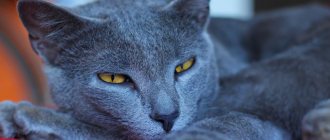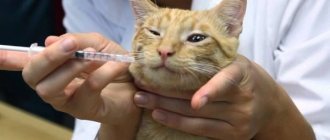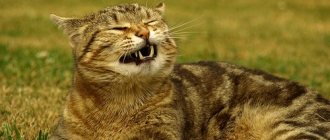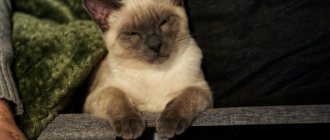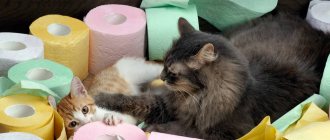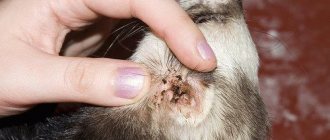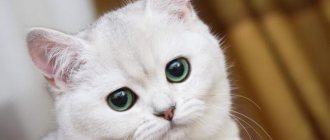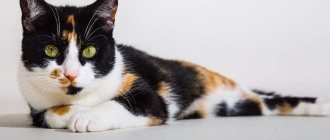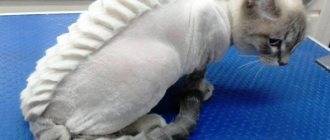Rickets is a serious and dangerous disease in animals. Therefore, at the first symptoms of the disease, it is necessary to seek help from specialists. Many owners try to overcome the problem on their own, using various folk remedies and recipes. But this can only lead to worsening symptoms. The more severe the form of the disease, the more difficult it is to fight it. Owners need to remember this. In order to effectively treat rickets, the doctor must find out the causes of the pathology, the complexity of the disease, how it proceeds and obtain many other data. Only with a comprehensive professional approach can you really help the animal.
Description of the disease
The disease does not cause significant discomfort for a young animal.
But if rickets in a kitten is not diagnosed and not treated on time, then the resulting changes in the body cannot be eliminated. In an adult animal, rickets does not develop. Rickets in cats after a year is observed only as visible consequences of a disease suffered in the cat's childhood.
Disruption of metabolic processes leads to a deficiency of calcium and phosphorus, which negatively affects the condition of the teeth, claws and skeletal system. Rickets in kittens leads to curvature and abnormal development of the animal's skeleton.
The leaching of calcium, which is a building material for bones and teeth, leads to softening. First of all, the joints and periosteum are affected, which is why the kitten’s growth slows down. Deforming processes in softened bones cause the skeleton to bend under the weight of the body.
Lack of calcium slows down protein synthesis. Because of this, the composition of bile changes, and serious disturbances in liver function are observed. Digestive processes are disrupted, which means the absorption mechanism of fats, minerals and vitamins is greatly deteriorated. And a lack of microelements in the body leads to endless constipation or diarrhea.
The same reason leads to a decrease in the fat layer and a sharp weight loss of the animal. An insufficient amount of calcium immediately affects the ability of the heart muscle to contract.
At-risk groups
The uniqueness of vitamin D is that it enters the body in two ways:
- through the mouth along with products containing it (in the first weeks of life - with mother’s milk);
- through the skin, where it is synthesized under the influence of ultraviolet rays.
Therefore, the baby purr can not only eat it, but also work it out while walking in the sun. From this conclusion it is not difficult to deduce the categories of animals most susceptible to vitamin D deficiency:
- offspring from cats deprived of adequate nutrition;
- kittens born in autumn and winter, deprived of walks in the sun.
Causes
Reasons leading to the development of pathology:
- An unbalanced diet is food with a lack of calcium and phosphorus, which happens when the kitten is switched to adult food too early, the wrong food is chosen, the kitten is fed mother’s milk for a short time, or there is a lack of fish and dairy products in the food.
- Insufficient care. Low lighting in the room where kittens are kept, insufficient ventilation, high humidity levels - this slows down metabolic processes, including calcium-phosphorus. A low level of light in the room means a lack of vitamin D, which also affects the metabolic process. High humidity also inhibits the production of this vitamin.
- Disturbances in the gastrointestinal tract, reducing the absorption of nutrients into the tissues of the animal’s body. Specifically, these are possible inflammatory processes of the small intestine, infections caused by bacteria, and the consequences of parasites.
- Artificial complementary feeding of insufficient quality instead of mother's milk.
- A sudden transfer of a kitten from feeding on mother's milk to adult food disrupts the functioning of the gastrointestinal tract and metabolic processes. This transition must be gradual and only using normal feed.
- Untimely pregnancy of a cat, when the mother’s health is impaired, the animal is in an emaciated state or, on the contrary, the cat is obese. Lack of nutrition during cat pregnancy leads to rickets in kittens.
Improper breeding is also a common cause of rickets in offspring. Frequent mating exhausts the cat's body, and kittens are born with pathologies. Closely related matings, matings of weakened and sick animals, matings of too young cats are also the reason for the development of rickets in babies.
Symptoms
Based on the symptoms of rickets in a kitten, treatment prescribed by a veterinarian in a timely and correct manner leads to the animal’s recovery. The depressed state must not be allowed to last too long, otherwise the consequences of the illness may be more severe.
Experienced breeders and veterinarians are unanimous in the statement that the main cause of rickets in offspring is a poorly balanced diet of the mother cat during the gestation period. Low content of amino acids, mainly taurine, leads to pathological development of fruits.
Disrupted metabolic processes provoke a lack of proteins, fat-soluble vitamin E, and ergocalciferol, which also negatively affects the development of kittens in the womb.
A symptom that attracts attention is a violation or absence of the sucking reflex in a kitten that is not able to find its mother's nipple on its own. Such a baby is weakened, moves little, and is exhausted.
If the symptoms of rickets in cats worsen to the point of modification of the skeleton, then it will be almost impossible to eliminate all the consequences. Lethargy, loss of body weight with excellent appetite should immediately alert the owner.
Symptoms of rickets in kittens include:
- unhealthy thinness with a large and bloated belly;
- unsteady walking: unsteadiness of gait due to poor development of the musculoskeletal system;
- inflammation of the pancreas, when enzymes for digesting food are poorly produced;
- shortness of breath due to myocardial insufficiency;
- compared to its peers, the kitten grows very slowly;
- a kind of “rosary” is observed - thickening of the joints of cartilage and bone tissue on the ribs (when stroking under the palm, you can feel the balls on the sides of the kitten’s ribs);
- the tubular bones of the limbs have “bracelets” - thickenings at the ends;
- the spine visually changes - the back sags;
- teeth change very slowly, much later than expected by age;
- the paws become uneven, then their curvature and lameness are possible;
- abnormally high appetite.
With rickets, the kitten will remain motionless for a long time. Due to thinness and lack of nutrients, muscles atrophy, and fragile bones are susceptible to fractures. Muscle cramps and ligament tears may occur.
Rickets has a destructive effect not only on the musculoskeletal system, but also on many other systems and organs: nervous, digestive, cardiovascular. Kittens with rickets often experience anemia and heart failure. A disturbed nervous system malfunctions in the form of frequent convulsions and seizures, the intensity of which often leads to the death of the pet.
Consequences
Rickets affects not only the musculoskeletal system. Disturbances occur in almost all organs and systems - cardiovascular, nervous, digestive.
The course of this disease does not pose a danger to the cat, but if left untreated it can lead to the development of disability in the animal. Significant curvature of the paws and inflammation of the joints lead to disruption of normal physical activity and significant lameness. The pelvic bones also change, which later causes serious complications during childbirth in the cat.
Deformation of the chest disrupts the normal functioning of the heart, leading to shortness of breath, coughing and rhythm disturbances. The functioning of the nervous system is disrupted, leading to seizures and convulsions; their frequent and prolonged exacerbations can lead to the death of the animal.
Laboratory diagnostic methods
Rickets in cats is diagnosed at the stage of mild symptoms, for which blood is taken from the animal for biochemistry and general analysis. The pathology will be observed in a significant decrease in calcium and phosphorus, a significant increase in alkaline phosphatase, and a decrease in blood clotting.
When making a diagnosis, the veterinarian prescribes an x-ray, which should show bone loss, curvature, thickening and deformation in the vertebral region and chest. A radioisotope study will also show all changes in the skeleton.
Systemic disorders can be diagnosed using abdominal ultrasound and electrocardiogram.
Hyperparathyroidism is very similar to rickets, i.e. dysfunction of the parathyroid gland. This disease also affects muscle tissue and the hepatorenal system. An ECG and ultrasound will show the difference.
Treatment
As soon as the owner notices symptoms of rickets in his pet, he should immediately go to a veterinarian. After treatment is prescribed, procedures must begin immediately. Any delay can aggravate the situation.
The purpose of the complex treatment required for rickets is to compensate for the lack of required substances in the kitten’s body. If the disease is at an early stage, then a positive outcome of complete recovery is highly likely.
First aid
Treatment of rickets in a kitten begins first of all with normalizing the presence of necessary substances in the body. For this purpose, droppers with calcium chloride or gluconate are prescribed. A solution of vitamin D is injected subcutaneously, and tetravit is prescribed orally - 10 drops.
After this, after a few days, the kittens are given fish oil capsules and added to their food. Additionally, vitamins B, A, and C may be prescribed by injection.
Basic treatment
It takes a lot of time to treat a kitten with rickets. The main treatment begins with the normalization of living conditions. Namely:
- providing a dry and bright living space with the possibility of prolonged exposure to natural daylight;
- the room should be ventilated regularly;
- provide the opportunity to walk in sunlight, and use an ultraviolet lamp in winter;
- increase the animal's physical activity through games and walks.
Your veterinarian will help you plan a diet, which is a very important part of your kitten's recovery.
- It is mandatory to introduce fermented milk products into the diet in the form of calcined cottage cheese, which is easily prepared using fresh milk and calcium chloride.
- Ensuring that food contains sufficient meat, fish, cereals, and egg yolks.
- Natural food can be replaced with ready-made food, specially designed for such cases. At the same time, mix natural food with ready-made industrial feed.
To restore the functions of internal organs after an illness, the following measures are introduced:
- You can restore the digestive system by using enzymes (pancreatin, mezim) with a gradual reduction in dosage. Taking and stopping medications should be carried out under the supervision of specialists. The liver will help restore galstena or karsil. Decoctions with an enveloping effect are beneficial for the stomach. For example, a decoction of flax seeds.
- To restore the impaired contractile function of the heart muscle, adonizide is suitable; blood supply will improve the prestranium.
- Chondroitin and glucosain are often prescribed for joints.
- Bionormalizer and trimetazidine will help speed up metabolism.
Severe damage to the cat’s body will require support for the cardiovascular system, for which purpose the kitten is given infusions of magnesium-containing drugs and cordiamine with camphor.
Prevention
As preventive measures against rickets in kittens, veterinary experts recommend the following:
- With the help of specialists, select the most optimally balanced diet for both a pregnant or lactating cat, and for kittens during the period of active growth.
- Provide your pet with timely vaccinations and the use of antihelminthic medications.
- After consulting with your veterinarian, you can take vitamin D and fish oil for preventive purposes.
- Properly plan the mating of a cat. In 12 months, no more than two births with good nutrition. You cannot breed weakened, infected, sick animals, and it is also not recommended to breed cats that are too obese or underweight.
- Painless weaning of a kitten from its mother – at least 2.5 months. It is better not to purchase an animal before this period, since breastfeeding must be complete.
- Cats, like dogs, need walks in the fresh air. If this is not possible, then the cat should be provided with exposure to the sun using open windows or a loggia.
Home prevention also includes therapeutic massages that improve blood circulation. At the same time, the kitten is given an active lifestyle through periodic walks and games.
Even in the case of timely diagnosis and proper treatment, an animal that has recovered from rickets will need close attention from its owners to its health status for life. Regular visits to the veterinary clinic for periodic examinations every 6 months will be necessary for life. There you will have to donate blood for biochemical analysis. Periodic vitamin therapy will not hurt either.
Only a responsible attitude of owners towards the health of their pets and their needs can make the life together of a person and an animal full and happy.
Signs of rickets
This problem will occur, or rather become apparent, between the ages of two and six months. It is at a time when the formation of a kitten occurs at some phenomenal pace that rickets can make itself known.
The diagnosis can be made if any of the symptoms listed below are present:
- growth and development delays;
- curvature of the spine, as well as curvature of the hind legs;
- lameness;
- noticeably higher thickness of joints, as well as ribs;
- delay in teeth change schedule;
- large abdominal volume, in combination with regular loose stools.
If your kitten shows signs of rickets, you need to see a doctor as soon as possible. Despite the fact that there are no terrible signs of the disease, you will not see blood and in general the kitten does not experience pain, if this problem is not corrected immediately, the kitten will simply die, because further the disease will develop too sharply for you to understand anything . Veterinarians have extensive experience in treating rickets, so everything will go perfectly.

